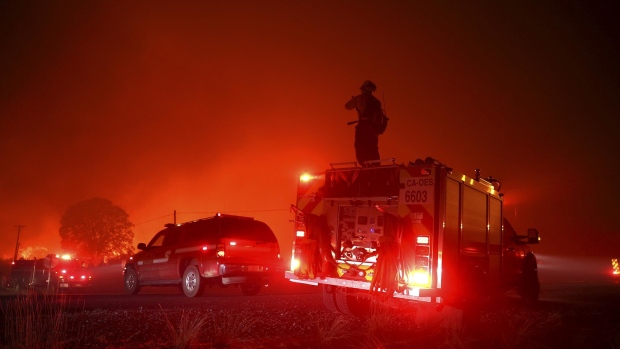Aug 18, 2021
Another California Town Ravaged by Wildfire as Winds Fan Flames
, Bloomberg News

(Bloomberg) -- A wildfire in the tinder-dry hills of Northern California tore through a small town and forced thousands to evacuate, as high winds fanned flames and caused blazes to rage out of control.
The Caldor Fire, which has swelled to more than 6,500 acres (2,600 hectares), burned through Grizzly Flats, destroying at least 50 homes in the hamlet of about 1,200 people east of Sacramento, according to the Associated Press. At least two people have been injured.
The devastation comes two weeks after another blaze, the Dixie Fire, eviscerated the Gold Rush-era town of Greenville and as California struggles with one of its worst fire seasons ever. The state faces a second day of intense winds on Wednesday, with gusts expected to reach 40 to 50 miles (64 to 80 kilometers) an hour, fanning flames across areas dried out by an historic drought gripping the U.S. West.
“It seems like today, in terms of the fire threat, tends to be the greatest,” said Richard Otto, a forecaster with the U.S. Weather Prediction Center.
Across the Northern Hemisphere, wildfires are sweeping areas left unusually dry this summer by drought and extreme heat blamed on climate change. A wildfire burning near the French Riviera killed one person this week and injured at least 27. A blaze outside Athens is forcing villages to evacuate.
In California, utility giant PG&E Corp. cut power to about 51,000 homes and businesses in fire-prone areas to prevent electrical lines from sparking more blazes if they toppled from high winds. The company said it would black out customers in parts of 18 counties.
“Everything is just ready to burn,” said Emily Heller, a meteorologist with the National Weather Service in Sacramento. On Monday, California broke a milestone of 1 million acres burned, the earliest it has ever reached that mark. Crews are battling 13 large blazes, including the Dixie and Caldor fires.
Dixie is the second-largest in California’s history. It’s been burning for more than a month, growing to 627,000 acres as of late Tuesday and destroying more than 1,200 structures, according to the California Department of Forestry and Fire Protection. The Caldor Fire began Saturday.
Across the Golden State, 6,540 fires this year have torched at least 1,800 structures. No deaths were reported through Tuesday.
As drastic as California’s fire season has been so far, it is still weeks away from its peak, when the Santa Ana and Diablo winds start to blow from the east. As summer weather patterns give way to fall, large high-pressure systems typically build over the Great Basin of Nevada and Utah, sending winds rushing from the east to low-pressure systems that often develop off the Pacific coast.
These winds dry out and heat up as they cross California’s mountain ranges, allowing them to fan any sparks they catch into major fires. Four of the state’s five most destructive fires occurred in October and November.
The danger often doesn’t pass until winter rain and snow squelch the flames. But the possibility of another La Nina event this fall and winter, the second in as many years, could bring California another dry winter.
Temperatures will linger in the 90s Fahrenheit through the rest of the week in the Sacramento area, Heller said. Air quality alerts due to smoke pollution have spread across the West, including through California’s Central Valley and covering almost all of Idaho and Wyoming.
(Adds detail beginning in the ninth paragraph.)
©2021 Bloomberg L.P.


